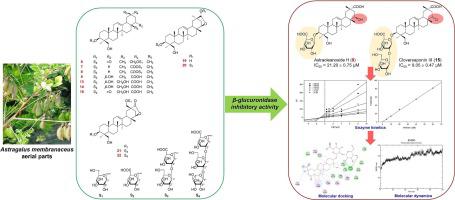当前位置:
X-MOL 学术
›
Bioorgan. Chem.
›
论文详情
Our official English website, www.x-mol.net, welcomes your feedback! (Note: you will need to create a separate account there.)
Astraoleanosides E–P, oleanane-type triterpenoid saponins from the aerial parts of Astragalus membranaceus Bunge and their β-glucuronidase inhibitory activity
Bioorganic Chemistry ( IF 5.1 ) Pub Date : 2024-02-20 , DOI: 10.1016/j.bioorg.2024.107230 Manh Khoa Nguyen , Viet Phong Nguyen , Seo Young Yang , Byung Sun Min , Jeong Ah Kim
Bioorganic Chemistry ( IF 5.1 ) Pub Date : 2024-02-20 , DOI: 10.1016/j.bioorg.2024.107230 Manh Khoa Nguyen , Viet Phong Nguyen , Seo Young Yang , Byung Sun Min , Jeong Ah Kim

|
Historically, Bunge has been used as a beneficial medicinal plant, particularly in the Asian traditional medical systems, for the treatment of various human diseases such as stomach ulcers, diarrhea, and respiratory issues associated with phlegm. In this study, a phytochemical characterization of the aerial parts of led to the isolation of 29 oleanane-type triterpenoid saponins, including 11 new compounds named astraoleanosides E–P (–, , , –), as well as 18 known ones. The structures of these compounds were elucidated using nuclear magnetic resonance (NMR) spectroscopy and high-resolution mass spectrometry. Among them, astraoleanoside H () and cloversaponin III () demonstrated the most potent -glucuronidase inhibitory activities, with IC values of 21.20 ± 0.75 and 9.05 ± 0.47 µM, respectively, compared to the positive control -saccharic acid 1,4-lactone (IC = 20.62 ± 1.61 µM). Enzyme kinetics studies were then conducted to investigate the type of inhibition exhibited by these active compounds. In addition, the binding mechanism, key interactions, binding stability, and dynamic behavior of protein–ligand complexes were investigated through approaches, such as molecular docking and molecular dynamics simulations. These findings highlight the promising potential of triterpenoid saponins from as lead compounds for -glucuronidase inhibitors, offering new possibilities for the development of therapeutic agents targeting various diseases where -glucuronidase plays a crucial role.
中文翻译:

黄芪地上部分的齐墩果烷苷 E-P、齐墩果烷型三萜皂苷及其 β-葡萄糖醛酸酶抑制活性
从历史上看,邦吉一直被用作有益的药用植物,特别是在亚洲传统医疗系统中,用于治疗各种人类疾病,如胃溃疡、腹泻和与痰有关的呼吸道问题。在这项研究中,通过对其地上部分的植物化学表征,分离出 29 种齐墩果烷型三萜皂苷,其中包括 11 种命名为 astraoleanosides E–P (–, , , –) 的新化合物,以及 18 种已知化合物。使用核磁共振(NMR)光谱和高分辨率质谱阐明了这些化合物的结构。其中,黄芪甲苷 H () 和三叶草皂苷 III () 表现出最强效的 β-葡萄糖醛酸酶抑制活性,与阳性对照 β-糖二酸 1,4-内酯相比,IC 值分别为 21.20 ± 0.75 和 9.05 ± 0.47 µM( IC = 20.62 ± 1.61 µM)。然后进行酶动力学研究以研究这些活性化合物所表现出的抑制类型。此外,通过分子对接和分子动力学模拟等方法研究了蛋白质-配体复合物的结合机制、关键相互作用、结合稳定性和动态行为。这些发现凸显了三萜皂苷作为β-葡萄糖醛酸酶抑制剂的先导化合物的巨大潜力,为开发针对β-葡萄糖醛酸酶发挥关键作用的各种疾病的治疗剂提供了新的可能性。
更新日期:2024-02-20
中文翻译:

黄芪地上部分的齐墩果烷苷 E-P、齐墩果烷型三萜皂苷及其 β-葡萄糖醛酸酶抑制活性
从历史上看,邦吉一直被用作有益的药用植物,特别是在亚洲传统医疗系统中,用于治疗各种人类疾病,如胃溃疡、腹泻和与痰有关的呼吸道问题。在这项研究中,通过对其地上部分的植物化学表征,分离出 29 种齐墩果烷型三萜皂苷,其中包括 11 种命名为 astraoleanosides E–P (–, , , –) 的新化合物,以及 18 种已知化合物。使用核磁共振(NMR)光谱和高分辨率质谱阐明了这些化合物的结构。其中,黄芪甲苷 H () 和三叶草皂苷 III () 表现出最强效的 β-葡萄糖醛酸酶抑制活性,与阳性对照 β-糖二酸 1,4-内酯相比,IC 值分别为 21.20 ± 0.75 和 9.05 ± 0.47 µM( IC = 20.62 ± 1.61 µM)。然后进行酶动力学研究以研究这些活性化合物所表现出的抑制类型。此外,通过分子对接和分子动力学模拟等方法研究了蛋白质-配体复合物的结合机制、关键相互作用、结合稳定性和动态行为。这些发现凸显了三萜皂苷作为β-葡萄糖醛酸酶抑制剂的先导化合物的巨大潜力,为开发针对β-葡萄糖醛酸酶发挥关键作用的各种疾病的治疗剂提供了新的可能性。



























 京公网安备 11010802027423号
京公网安备 11010802027423号